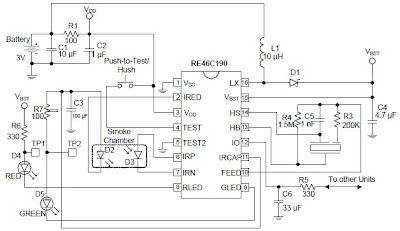
Using this photoelectric smoke detector circuit can be designed a very simple and low power smoke detector alarm project that is based on the RE46C190 smoke detector IC .
With minimal external components, this smoke detectors alarm circuit will provide all the
required features for a photoelectric smoke detector type electronic project .The design incorporates a gain-selectable photo amplifier for use with an infrared emitter detector pair.
An internal oscillator strobes power to the smoke detection circuitry every 10 seconds, to keep the standby current to a minimum. If smoke is sensed, the detection rate is increased to verify an Alarm condition.
This photoelectric smoke detector circuit type smoke detector alarm will check for a low battery condition every 86 seconds, and chamber integrity is tested once every 43 seconds, when in Standby. The temporal horn pattern supports the NFPA 72 emergency evacuation signal.
Pin nr 12 us an interconnect pin that allows multiple detectors to be connected such that, when one unit alarms, all units will sound (using pin 12 pin you can create a smoke detector alarm circuit for many rooms ).
Utilizing low power CMOS technology, the RE46C190 was designed for use in smoke detectors that comply with Underwriters Laboratory Specification UL217 and UL268.
This smoke detector circuit project require a 3 volt DC power supply circuit , you can also use a simple 3 volt battery ( because it has a very low power consumption ) .
C2 should be located as close as possible to the device power pins, and C1 should be located as close as possible to VSS.
Schottky diode D1 must have a maximum peak current rating of at least 1.5A (for best results it should have forward voltage specification of less than 0.5V at 1A, and low reverse leakage) and L1 inductor must have a maximum peak current rating of at least 1.5A.


